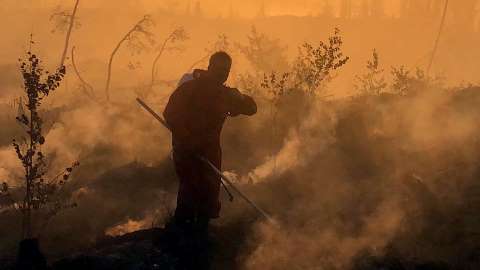Guidelines improve monitoring of forest fires

The guidelines are freely available and can be used in all parts of Sweden. They have been drawn up by a working group consisting of representatives from Skogforsk (Forest Research Institute of Sweden), MSB (The Swedish Civil Contingencies Agency), several emergency services, the MR (Maskinringen) groups, the Swedish Association of Fire Protection, the insurance industry, and forestry representatives.
“The guidelines comprise simple, concrete advice and instructions to landowners on how to monitor a forest fire, for which they are responsible by law. We’ve also put together a check list that the operational commander can use when informing landowners about their obligations to monitor a forest fire,” says Rolf Björheden, senior researcher at Skogforsk and coordinator of the working group.
According to an official investigation, the cause of around 70 percent of the total area of forest fires in Sweden in 2018 was smaller fires flaring up after the forest fire had been extinguished.
“The joint guidelines support firefighting services and landowners in the important transition from direct firefighting to the landowner’s monitoring of the fire area. If the guidelines are used, the risk of forest fires spreading over large areas during the course of several days, which was the case in 2018, will be reduced,” says Jenny Sander, forest fire officer at MSB.
Similar work methods
According to Christer Björkman, operations strategist at the fire service in Umeå, there are already functioning guidelines used by several large landowners and fire brigades. The problems are that they are not consistent and that minor players completely lack guidelines.
“It’s therefore helpful that guidelines, drawn up by many different parties, are now freely available. It makes it easier for us to work in a similar manner and for landowners to monitor forest fires more effectively,” he says.
According to Rolf Björheden, Skogforsk, it is a great advantage if contact is established between the fire brigade and the landowner as soon as possible, preferably already when the fire brigade is on its way to the fire area.
“Landowners need information rapidly. Early contact gives them the best opportunities to prepare and carry out their part of the work, primarily to monitor the fire after it’s been extinguished,” he says.
Guidelines for monitoring an extinguished forest fire
The guidelines are based on three documents:
1. "Monitoring forest fires – Advice and information to landowners"
Information and tips how to monitor an extinguished forest fire.
2. "Concluding firefighting operations – Checklist for the operational commander"
Supports the operational commander in transferring responsibility to the landowner on completion of the firefighting operation.
3. "Documentation for concluding a firefighting operation after a forest fire, and information to affected landowners"
Form on which important information relevant to the fire incident can be communicated and documented.
All the documents apply throughout Sweden and can be freely downloaded from Skogforsk’s theme page about forest fires: skogforsk.se/skogsbrand

